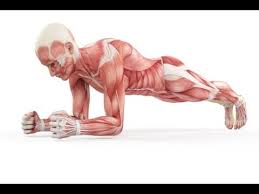 What is the plank?
What is the plank?
The plank is an isometric core strengthening exercise.
What muscles are used in the plank?
The better question would be what muscles aren’t used while performing the plank. There is a long list of core stabilizing muscles and primary movers that make the plank possible to hold and depending on your current fitness level also determines how long you can hold the position. The primary muscles involved in the plank are: erector spinae, rectus abdominis, and transverse abdominis. The secondary muscles include: synergists/segmental stabilizers, trapezius, rhomboids, rotator cuff, all three deltoid muscles, pectorals, serratus anterior, gluteus maximus, quadriceps and gastrocnemius.
Why do we plank?
As mentioned the plank is a core stabilization exercise and we plank simply because of the number of muscle groups that are targeted with one exercise. Also there is no equipment needed, just you and the floor.
How to perform the plank:
Begin lying on your stomach on the floor or on an exercise mat w/ your elbows close to your sides and directly under shoulders, palms down, fingers facing forward. Engage your abdominal muscles as if you were placing a brace around your ribs, waist and torso. Contract your thigh muscles, straighten your legs and flex the ankles, tucking your toes.
Slowly lift your torso and thighs off the floor keeping your torso and legs rigid. Do not allow any sagging in the lower back or rib cage and avoid hiking your hips into the air or bending knees
Begin by holding for 30-40 seconds and repeating 2-3 times
If you notice any pain in the lower back or any other area of the body stop the exercise and consult with your doctor
Plank variations include:
The plank can be performed on the forearms, with extended arms as in the top of a push-up, lifting one arm or leg at a time or lifting alternate arm and leg,i.e, right arm, left leg, side plank or a modification can be made by simply dropping to the needs.
*Do not perform any exercise if you are experiencing dizziness, nausea, light-headedness, or are not experienced with the exercise. Please contact your Cenegenics Doctor or exercise professional to assist you with proper execution.
